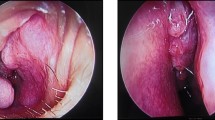Abstract
Craniopharyngiomas (CP) ectopic localizations off the midline outside the sellar-suprasellar region are very rare and most often associated to secondary tumor dissemination, being primary ectopic CPs extremely unusual. We herein report the first case of a primary ectopic craniopharyngioma within the orbit. A 15-year-old patient presented with progressive right ptosis, proptosis, and retro ocular pain. Magnetic resonance imaging (MRI) showed a predominantly cystic lesion, occupying the superolateral right corner of the orbit, outside the intraconal space with no evidence of intracranial involvement. An endoscopic transorbital eyelid approach was adopted. Pathology report disclosed a primary ectopic craniopharyngioma.




Similar content being viewed by others
References
Bajric J, Griepentrog GJ, Mohney BG (2019) Pediatric periocular dermoid cysts: incidence, clinical characteristics, and surgical outcomes. Ophthalmic Epidemiol 26:117–120. https://doi.org/10.1080/09286586.2018.1525412
Bunin GR, Surawicz TS, Witman PA, Preston-Martin S, Davis F, Bruner JM (1997) The descriptive epidemiology of craniopharyngioma. Neurosurg Focus 3:e1. https://doi.org/10.3171/foc.1997.3.6.4
Cai M, He H, Zhang B, Luo L, Gong J, Li W, Huang T, Guo Y (2019) An ectopic recurrent craniopharyngioma of the temporal lobe: case report and review of the literature. World Neurosurg 126:216–222. https://doi.org/10.1016/j.wneu.2019.02.196
Cavallo LM, Frank G, Cappabianca P, Solari D, Mazzatenta D, Villa A, Zoli M, D’Enza AI, Esposito F, Pasquini E (2014) The endoscopic endonasal approach for the management of craniopharyngiomas: a series of 103 patients. J Neurosurg 121:100–113. https://doi.org/10.3171/2014.3.JNS131521
Dallan I, Castelnuovo P, Turri-Zanoni M, Fiacchini G, Locatelli D, Battaglia P, Sellari-Franceschini S (2016) Transorbital endoscopic assisted management of intraorbital lesions: lessons learned from our first 9 cases. Rhinology 54:247–253. https://doi.org/10.4193/Rhin15.237
Di Somma A, Andaluz N, Cavallo LM, de Notaris M, Dallan I, Solari D, Zimmer LA, Keller JT, Zuccarello M, Prats-Galino A, Cappabianca P (2018) Endoscopic transorbital superior eyelid approach: anatomical study from a neurosurgical perspective. J Neurosurg 129:1203–1216. https://doi.org/10.3171/2017.4.JNS162749
Di Somma A, Andaluz N, Cavallo LM, Keller JT, Solari D, Zimmer LA, de Notaris M, Zuccarello M, Cappabianca P (2018) Supraorbital vs endo-orbital routes to the lateral skull base: a quantitative and qualitative anatomic study. Oper Neurosurg (Hagerstown) 15:567–576. https://doi.org/10.1093/ons/opx256
Gabel BC, Cleary DR, Martin JR, Khan U, Snyder V, Sang UH (2017) Unusual and rare locations for craniopharyngiomas: clinical significance and review of the literature. World Neurosurg 98:381–387. https://doi.org/10.1016/j.wneu.2016.10.134
Jane JA, Laws ER (2006) Craniopharyngioma. Pituitary 9:323–326. https://doi.org/10.1007/s11102-006-0413-8
Karavitaki N, Cudlip S, Adams CB, Wass JA (2006) Craniopharyngiomas. Endocr Rev 27:371–397. https://doi.org/10.1210/er.2006-0002
Magill JC, Ferguson MS, Sandison A, Clarke PM (2011) Nasal craniopharyngioma: case report and literature review. J Laryngol Otol 125:517–519. https://doi.org/10.1017/S0022215110002938
Mombaerts I, Ramberg I, Coupland SE, Heegaard S (2019) Diagnosis of orbital mass lesions: clinical, radiological, and pathological recommendations. Surv Ophthalmol 64:741–756. https://doi.org/10.1016/j.survophthal.2019.06.006
Norris JL, Cleasby GW (1981) Endoscopic orbital surgery. Am J Ophthalmol 91:249–252. https://doi.org/10.1016/0002-9394(81)90183-5
Pelton RW (2009) The anterior eyelid crease approach to the orbit. Curr Opin Ophthalmol 20:401–405. https://doi.org/10.1097/ICU.0b013e32832ec3f7
Pena AH, Chaudhry A, Seidman RJ, Peyster R, Bangiyev L (2016) Ectopic craniopharyngioma of the fourth ventricle in a patient with Gardner syndrome. Clin Imaging 40:232–236. https://doi.org/10.1016/j.clinimag.2015.11.005
Preti A, Karligkiotis A, Facco C, Ottini G, Volpi L, Castelnuovo P (2017) Primary ectopic ethmoidal craniopharyngioma. J Craniofac Surg 28:944–946. https://doi.org/10.1097/SCS.0000000000003426
Prevedello DM, Solari D, Carrau RL, Gardner P, AB K (2012) Endoscopic endonasal approach for craniopharyngiomas.
Rao AA, Naheedy JH, Chen JY, Robbins SL, Ramkumar HL (2013) A clinical update and radiologic review of pediatric orbital and ocular tumors. J Oncol 2013:975908. https://doi.org/10.1155/2013/975908
Schoenfeld A, Pekmezci M, Barnes MJ, Tihan T, Gupta N, Lamborn KR, Banerjee A, Mueller S, Chang S, Berger MS, Haas-Kogan D (2012) The superiority of conservative resection and adjuvant radiation for craniopharyngiomas. J Neurooncol 108:133–139. https://doi.org/10.1007/s11060-012-0806-7
Tailor TD, Gupta D, Dalley RW, Keene CD, Anzai Y (2013) Orbital neoplasms in adults: clinical, radiologic, and pathologic review. Radiographics 33:1739–1758. https://doi.org/10.1148/rg.336135502
Tawfik HA, Dutton JJ (2018) Embryologic and fetal development of the human orbit. Ophthalmic Plast Reconstr Surg 34:405–421. https://doi.org/10.1097/IOP.0000000000001172
Yaşargil MG, Curcic M, Kis M, Siegenthaler G, Teddy PJ, Roth P (1990) Total removal of craniopharyngiomas. Approaches and long-term results in 144 patients. J Neurosurg 73:3–11. https://doi.org/10.3171/jns.1990.73.1.0003
Author information
Authors and Affiliations
Corresponding author
Ethics declarations
Ethics approval
All procedures performed in studies involving human participants were in accordance with the ethical standards of the institutional and/or national research committee and with the 1964 Helsinki declaration and its later amendments or comparable ethical standards.
Additional information
Publisher's note
Springer Nature remains neutral with regard to jurisdictional claims in published maps and institutional affiliations.
This article is part of the Topical Collection on Brain Tumors
Supplementary information
Below is the link to the electronic supplementary material.
Supplementary file1 Removal of a primary ectopic craniopharyngioma thought an endoscopic transorbital eyelid approach. (MP4 264424 KB)
Rights and permissions
About this article
Cite this article
Vitulli, F., D’Avella, E., Solari, D. et al. Primary ectopic orbital craniopharyngioma. Acta Neurochir 164, 1979–1984 (2022). https://doi.org/10.1007/s00701-021-04969-y
Received:
Accepted:
Published:
Issue Date:
DOI: https://doi.org/10.1007/s00701-021-04969-y




